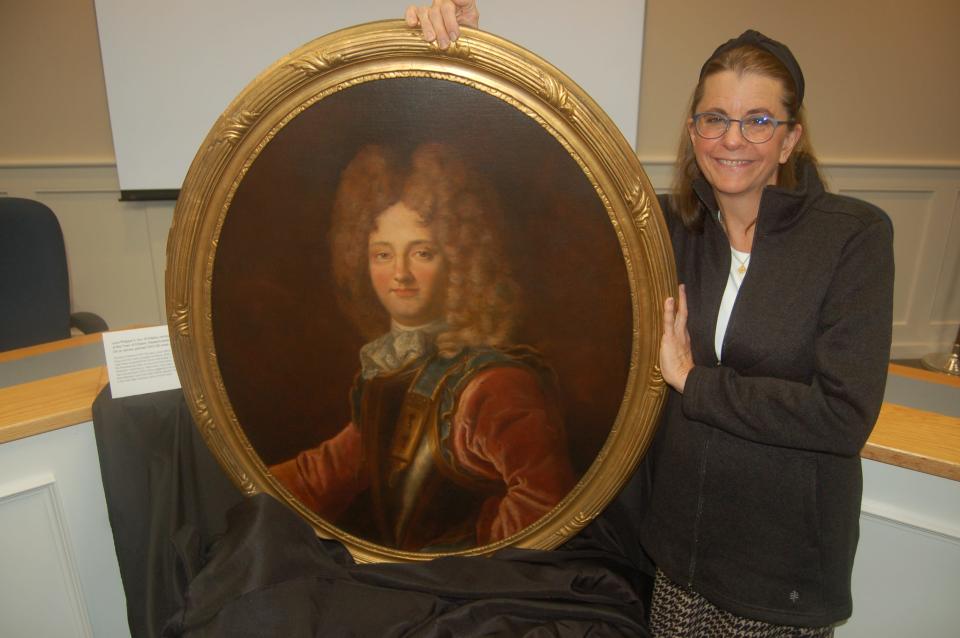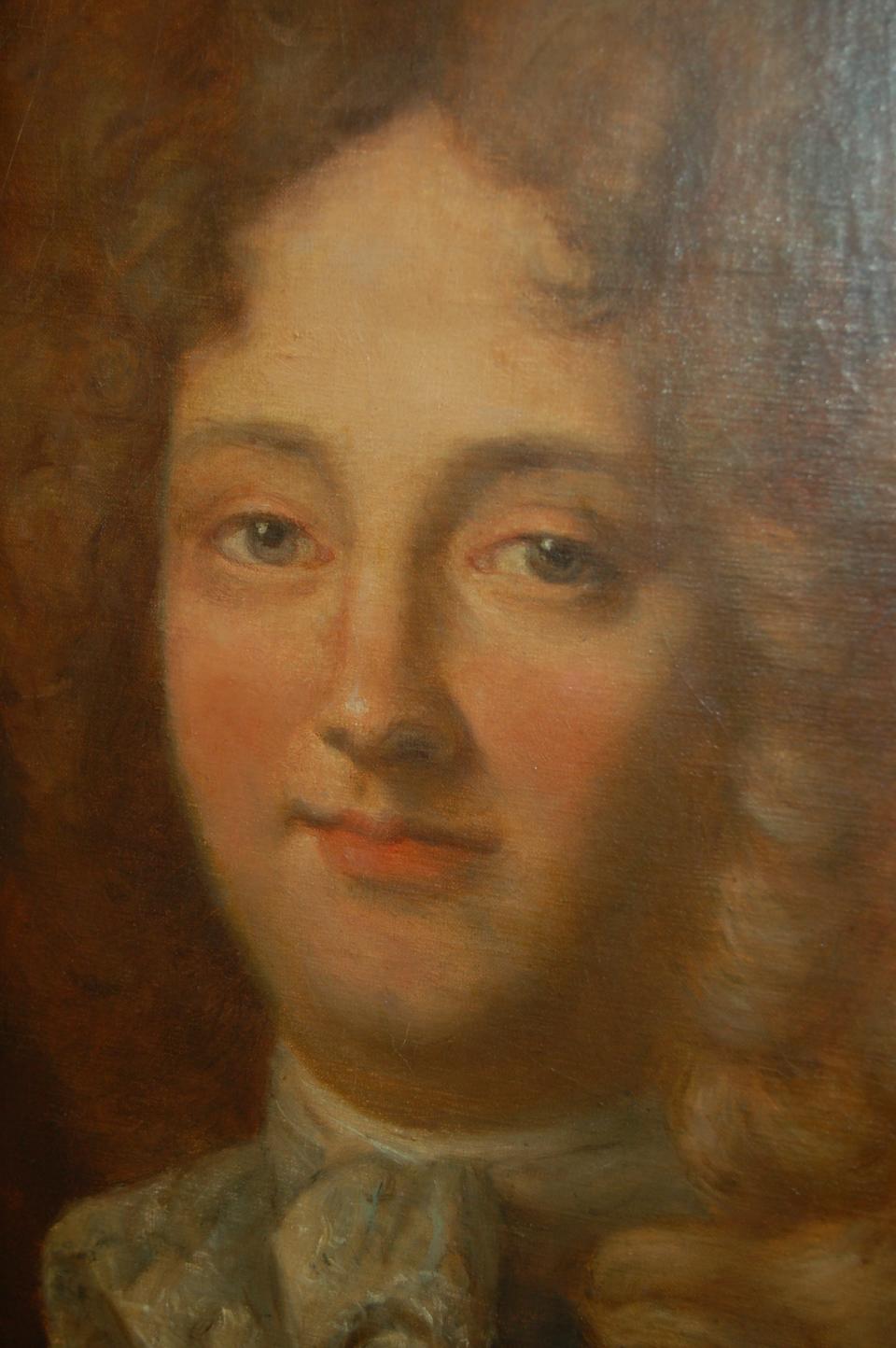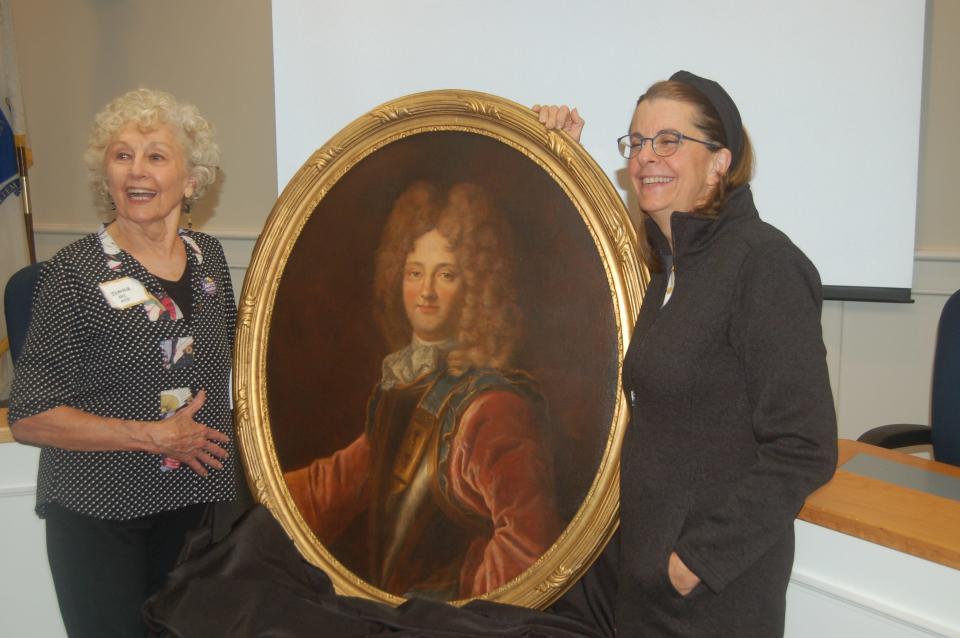See who Orleans is named for. Portrait of French duke restored and on display
ORLEANS —Most people know Orleans has a French connection that has nothing to do with the movie, after all the French Cable Museum is right on Route 28.
But the town has another direct line to French royalty. The town is named after Louis Philippe II, the last Duke of Orleans.
More: What's it like to live in a local historic district? Orleans ponders its first
On Sept. 23, 229 years after his death, the town paid homage to this noblest of noblemen with a reception unveiling his fully restored portrait. The painting had moldered and cracked in a downstairs closet for years. Now it will hang outside Town Hall’s main meeting room celebrating the democracy the free-thinking duke championed.

“This is a really amazing event considering it started four centuries ago,” Johanna Keeley, former chair of the Cultural Council, said. “Thank you to the donors that made the restoration happen. We started this before COVID and some supplies had to come from France which took awhile.”
“This is something to celebrate now that we have his bright wonderful eyes peering out from another century,” Select Board Chair Andrea Reed said in a statement read by fellow board member Michael Herman. “Well done Cultural Council. Thank you.”

How Orleans was named for French duke
Orleans was a part of Eastham until 1797 when the towns split after building two meetinghouses. What had been the southern parish of Eastham needed a name.
“Isaac Snow, was born in 1758. The house he was born in is on Barley Neck Road. At 17 he served in the Revolutionary War,” Orleans Historical Society Chair Jay Stradal said. “He served on land and sea and was captured by the British twice. The first time he was held on a POW ship off Portugal and he escaped and walked to France. That’s probably where he heard about the Duke of Orleans.”
More: Here's the story behind the chair on Brewster's town seal. Is it time for a change?
There were many dukes of Orleans, as it was a royal title, but the one in question, Louis Philippe II, was born April 13, 1747. He didn’t actually become duke until 1785, after Snow was in France. His cousin, Louis XVI, was the king.

“He was a 30-year-old naval officer,” Stradal said of the future duke. “He was strong in support of liberty and the cause of the (American) revolution. After the war, Isaac returned home married and had 12 children. In 1797 the two parishes of Eastham separated.”
Unfortunately the duke’s love of liberty wasn’t enough to help him survive the French Revolution even though he was initially a supporter and renounced his royal title. He was executed on the guillotine in 1793, four years before Orleans was founded.
“Isaac suggested they name the town after the Duke of Orleans and that was accepted which is why it’s Orleans today,” Stradal said. “In the War of 1812 Isaac was the head of the militia that repelled the British from Rock Harbor. He died at age 97 in 1855. He was the last Revolutionary War veteran on Cape Cod.”
The Snow name is carried on by Snow’s Home and Garden on Main Street, Snow Shore, the Snow Library and other locations in town.
More: What's 50 years old this weekend? The rare French Cable Station Museum in Orleans
The portrait dates from 1816 and the artist is unknown, according to Debra Dickinson of Dickinson Fine Art in Wellfleet, who spent two years restoring the picture. She is still researching and hopes to find the artist’s name. Dickinson said she believes the picture is a copy of the original which hasn’t been located – perhaps it perished in the revolution as well. There is a portrait of an older version of the duke at Versailles. This portrait has him at around age 30.
The portrait was bought at an auction years a ago and donated anonymously to the town, Keeley said.
“It was put into a closet on the first floor,” Keeley said.
When the Orleans Cultural District Committee decided to add a sculpture of the duke as part of the holiday display, the sculptor wanted a picture of the duke to serve as a model and the town remembered they had one, she said.
That sculpture, 14-feet-wide and 8-feet-high is now in the Hurd Chapel. Meanwhile the Cultural Council was distressed by the condition of the portrait which had extensive cracking and flaking of the paint. They called in Dickinson for a look and launched a fundraising campaign.
What was involved in restoring the duke
“This kind of work for me is deeply rewarding,” Dickinson said, “I could immediately see the trouble the portrait was in. It was a well-painted portrait. But the entire portrait was cracked everywhere like a jigsaw. The edge of every piece was curling and on the verge of popping off the panel.”
Dickinson has been doing conservation and restoration for more than 30 years and specializes in family portraits mostly working for collections and museums.
“He’s so charming," she said of the duke. "Most (portraits) are very serious. He’s so intriguing. He was wildly popular in France. It’s amazing what he did.”
She said three areas of study are required to restore a painting — studio art, color matching and art history.
More: Colonialism key part of Queen Elizabeth II's legacy for Cape Cod communities of color
“When you restore a painting you want to consider the artist’s original intent. You want the methods and materials to be long lasting and high quality,” she said. “We think of a painting as two dimensional but I know there are many layers: the wooden stretcher, the canvas, sizing applied to the canvas to saturate it (it penetrates the pores of the fibers), the primer or gesso, the oil paint and the varnish.”
The restoration is layer by layer and starts with an adhesive applied to the stretcher so the cracked paint can be pressed back flat flake by flake.
“This painting was unstable at an early age,” Dickinson said. “The paint layer was stressed. The cracks were so long and dry and brittle. The two backings applied (rabbit skin glue and beeswax) did not hold up.”
The painting was also covered by soot, grim, nicotine, mold and insect excretions. Someone had inserted Christmas decorations between the stretcher and canvas. She removed the animal glue and beeswax then started the reconsolidation process with new adhesives to the fibers. She said normally the work would take nine months but waiting for supplies from France added time.
Where you can see the duke
“This restoration should last 80 to 100 years,” she said. “I returned it to the wooden stretcher and removed the film (from the front of the portrait) and then removed the nicotine, soot etc. I very carefully cleaned it one square inch at a time under magnification. A lot of the face had been repainted and covered up so this is the original with the smile and sparkling eyes.”
More: Books being challenged at 'alarming rate' nationally, says Cape librarian
A new layer of varnish was applied.
“I take great care and provide a combination of what I learned in Italy and the U.S.,” she said. “I do not utilize high gloss varnish. I preserve the character that comes with age. You have to wait between the stages to let things settle in.”
The portrait will be hung on the second floor of Town Hall on School Road outside the select board’s meeting room.
Contact Rich Eldred at reldred@capecodonline.com. Follow him on Twitter: @reldredCodder.
Gain access to premium Cape Cod Times content by subscribing.
This article originally appeared on Cape Cod Times: Cape town restores portrait of French duke it is named after

